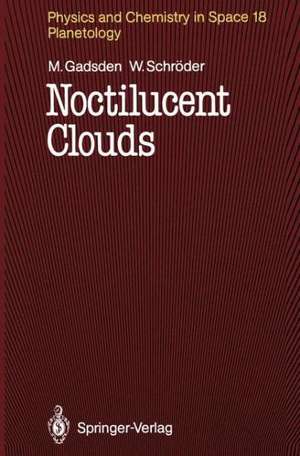Noctilucent Clouds: Physics and Chemistry in Space, cartea 18
Autor Michael Gadsden, Wilfried Schröderen Limba Engleză Paperback – 9 apr 2012
Din seria Physics and Chemistry in Space
-
 Preț: 385.84 lei
Preț: 385.84 lei -
 Preț: 382.18 lei
Preț: 382.18 lei - 15%
 Preț: 643.84 lei
Preț: 643.84 lei -
 Preț: 383.50 lei
Preț: 383.50 lei - 18%
 Preț: 729.84 lei
Preț: 729.84 lei - 15%
 Preț: 642.83 lei
Preț: 642.83 lei - 15%
 Preț: 637.59 lei
Preț: 637.59 lei -
 Preț: 385.08 lei
Preț: 385.08 lei -
 Preț: 381.98 lei
Preț: 381.98 lei - 15%
 Preț: 637.78 lei
Preț: 637.78 lei - 15%
 Preț: 634.49 lei
Preț: 634.49 lei -
 Preț: 388.34 lei
Preț: 388.34 lei -
 Preț: 392.21 lei
Preț: 392.21 lei - 15%
 Preț: 697.47 lei
Preț: 697.47 lei -
 Preț: 382.18 lei
Preț: 382.18 lei - 15%
 Preț: 643.84 lei
Preț: 643.84 lei - 15%
 Preț: 638.43 lei
Preț: 638.43 lei -
 Preț: 383.50 lei
Preț: 383.50 lei -
 Preț: 385.08 lei
Preț: 385.08 lei -
 Preț: 385.08 lei
Preț: 385.08 lei - 18%
 Preț: 778.32 lei
Preț: 778.32 lei - 18%
 Preț: 777.83 lei
Preț: 777.83 lei -
 Preț: 381.81 lei
Preț: 381.81 lei
Preț: 381.43 lei
Nou
Puncte Express: 572
Preț estimativ în valută:
72.98€ • 76.61$ • 60.58£
72.98€ • 76.61$ • 60.58£
Carte tipărită la comandă
Livrare economică 10-24 aprilie
Preluare comenzi: 021 569.72.76
Specificații
ISBN-13: 9783642486289
ISBN-10: 3642486282
Pagini: 180
Ilustrații: IX, 165 p. 53 illus.
Dimensiuni: 155 x 235 x 9 mm
Greutate: 0.26 kg
Ediția:Softcover reprint of the original 1st ed. 1989
Editura: Springer Berlin, Heidelberg
Colecția Springer
Seria Physics and Chemistry in Space
Locul publicării:Berlin, Heidelberg, Germany
ISBN-10: 3642486282
Pagini: 180
Ilustrații: IX, 165 p. 53 illus.
Dimensiuni: 155 x 235 x 9 mm
Greutate: 0.26 kg
Ediția:Softcover reprint of the original 1st ed. 1989
Editura: Springer Berlin, Heidelberg
Colecția Springer
Seria Physics and Chemistry in Space
Locul publicării:Berlin, Heidelberg, Germany
Public țintă
ResearchCuprins
1 Noctilucent Clouds.- 1.1 Introduction.- 1.2 How, When and Where Noctilucent Clouds Are Seen.- 1.3 Amateur Observations.- 1.4 CloudTypes.- 1.5 Structure of the Upper Atmosphere.- 2 History.- 2.1 Introduction.- 2.2 The Discovery of the “Shining Night-Clouds”.- 2.3 Measurements of Noctilucent Clouds.- 2.4 The Middle Period of Noctilucent Cloud Research.- 3 Observations from Ground Level.- 3.1 Introduction.- 3.2 The Geometry of Twilight Scattering.- 3.3 Latitude of Observation.- 3.4 Absorption of Light in the Atmosphere.- 3.5 Height of Noctilucent Clouds.- 3.6 Drift Motions.- 3.7 Wave Structure.- 4 Spectrophotometry.- 4.1 Introduction.- 4.2 Spectroscopic Observations.- 4.3 Spectrophotometry from Ground Level.- 4.4 Rocket-Borne Photometers.- 4.5 Spectrophotometry from Satellites.- 4.6 Conclusions About Cloud Particle Sizes.- 5 Polarimetry.- 5.1 Introduction.- 5.2 Polarization by Scattering.- 5.3 Measurement of Polarized Light.- 5.4 Polarization Measured from Ground Level.- 5.5 Measurements of Polarization from Rockets.- 5.6 Conclusions About Cloud Particle Sizes.- 6 Rocket-Borne Sampling.- 6.1 Introduction.- 6.2 Flights over Sweden in 1962 and 1967.- 6.3 Rights over Sweden in 1970 and 1971.- 6.4 Flights over Canada in 1968 and 1970.- 6.5 Collectors Flown by Max-Planck-Institut Researchers, 1968 to 1971.- 6.6 Conclusions About Cloud Particle Sizes.- 7 Variation of Occurrence.- 7.1 Introduction.- 7.2 Sunspot Cycle.- 7.3 Seasonal Frequency of Noctilucent Clouds.- 7.4 Climatology of the Mesosphere.- 8 Other Observations.- 8.1 Introduction.- 8.2 Association with Hydroxyl Airglow Emission.- 8.3 Association with Aurora and Planetary Magnetic Activity.- 8.4 Lunar Effects.- 8.5 Lidar Observations.- 8.6 Artificial Noctilucent Clouds.- 8.7 Abnormal Observations.- 9 Environment ofNoctilucent Clouds.- 9.1 Introduction.- 9.2 Atmospheric in Temperature.- 9.3 D-Region.- 9.4 Dust.- 9.5 Water Vapour in the Mesosphere.- 9.6 Radiation.- 9.7 Rates of Growth.- 9.8 Nucleation of Ice.- 9.9 Settling of Particles.- 9.10 Modelling Noctilucent Clouds by Numerical Simulation.- 10 The Nature of Noctilucent Clouds.- 10.1 Introduction.- 10.2 Formation in Noctilucent Clouds.- 10.3 Growth of Noctilucent Cloud Particles.- 10.4 Evaporation of Noctilucent Cloud Particles.- 10.5 The Relationship Between Polar Mesospheric Clouds and Noctilucent Clouds.- 10.6 Summary.- 11 Bibliography.- A) Before 1900.- B) 1900–1950.- C) Bibliography since 1950.- Appendix 1: Atmospheric Refraction.- Appendix 2: Atmospheric Transmission Along Grazing Pays.- Name Index.












